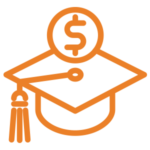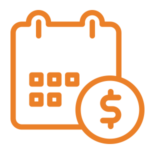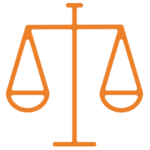Teacher Loan Forgiveness Program (TLFP)
Teaching is a profession that requires a great deal of talent and responsibility, and it provides educators with many personal rewards. Congress provided another incentive to teach when it established the Teacher Loan Forgiveness Program (TLFP) to encourage individuals to teach in certain elementary and secondary schools that serve low-income families.
Under the TLFP, if you borrow a Federal Stafford or Federal Direct loans (and in certain cases, a Federal Consolidation or Direct Consolidation loan), and you teach for five consecutive, complete years at an eligible school, you may qualify to have up to $5,000 ($17,500 for certain highly qualified secondary math and science teachers, and elementary and secondary special education teachers) of your loan balance forgiven.
Eligibility Requirements
The following are general eligibility requirements for borrowers seeking teacher loan forgiveness:
- You must not have had an outstanding balance on a Federal Family Education Loan Program (FFELP) or Federal Direct Loan Program (FDLP) loan as of October 1, 1998, or on the date you obtained a FFELP or FDLP loan after October 1, 1998.
- You must have been employed as a full-time teacher for five complete, consecutive academic years at a qualifying location (effective for teacher loan forgiveness applications received on or after August 14, 2008) or a low-income eligible school. An eligible school is considered “low-income” according to certain criteria for funding under Title I of the Elementary and Secondary Education Act and is listed in the Annual Directory of Designated Low-Income Schools for Teacher Cancellation Benefits. At least 30 percent of an eligible school’s enrolled students must qualify for services provided under Title I.
- If the school where you performed your teaching service meets the criteria of an eligible school for any year of your qualifying teaching service, that year and all subsequent years of service at that school continue to qualify you for forgiveness, even if the school is no longer eligible.
- If the school where you performed your teaching service meets the eligibility criteria of an eligible school after you have started your service, you won’t gain any retroactive qualifying teaching service for previous years of employment at that school.
- You must have performed at least one of your five years of qualifying service after the 1997-1998 academic year.
- The loan for which you are seeking forgiveness must have been made before the end of the fifth year of your qualifying teaching service.
- If you are seeking loan forgiveness for a defaulted loan, you must make satisfactory repayment arrangements to re-establish your federal student aid eligibility. Contact Trellis Borrower Services at (800) 222-6297 or borrowerservices@trelliscompany.org for more details.
- You may not receive both teacher loan forgiveness and an AmeriCorps benefit for the same teaching service.
- You may not receive more than a total of $5,000 ($17,500 for certain highly qualified secondary math and science teachers, and elementary and secondary special education teachers) in loan forgiveness for outstanding principal and accrued interest under both the FFELP and the FDLP.
In addition to meeting the general eligibility requirements for teacher loan forgiveness, you must also obtain certification from your school’s chief administrative officer (usually your human resources official, principal, assistant principal, or district superintendent) or the chief administrative officer of your educational service agency (effective for teacher loan forgiveness applications received on or after August 14, 2008) that you meet the requirements outlined in one of the sections below. Each chart provides the maximum amount of loan forgiveness for which borrowers meeting each set of requirements are eligible.
To qualify for up to $5,000 in loan forgiveness
If your qualifying teaching service began before October 30, 2004, you must meet one of the following criteria:
- If you performed your teaching service at an eligible elementary school, you demonstrated knowledge and teaching skills in reading, writing, mathematics, and other areas of the school’s curriculum.
- If you performed your teaching service at an eligible secondary school, you taught in a subject area that is relevant to your academic major.
- During your qualifying teaching service as a public school teacher at an eligible elementary or secondary school, you met the definition of “highly qualified” as provided in the No Child Left Behind Act of 2001.
If your qualifying teaching service began on or after October 30, 2004, and you performed your teaching service as a public school teacher* at an eligible elementary or secondary school, you must have met the definition of “highly qualified” as provided in the No Child Left Behind Act of 2001.
If you have already received $5,000 in forgiveness, to qualify for up to an additional $12,500 in loan forgiveness
You must meet both of the following criteria for five consecutive, complete academic years of your teaching service:
- If you performed your qualifying teaching service as a public school teacher at an eligible elementary or secondary school, you must have met the definition of “highly qualified” as provided in the No Child Left Behind Act of 2001.
- You must have been employed either:
- as a mathematics or science teacher at an eligible secondary school, or
- as a special education teacher whose primary responsibility was to provide special education to children with disabilities at an eligible elementary or secondary school. In addition, if you’re a special education teacher, you must have taught children with disabilities that correspond to your special education training.
To qualify for up to $17,500 in loan forgiveness
You must meet both of the following criteria for five consecutive, complete academic years of your teaching service:
- If you performed your qualifying teaching service as a public school teacher at an eligible elementary or secondary school, you must have met the definition of “highly qualified” as provided in the No Child Left Behind Act of 2001.
- You must have been employed either:
- as a mathematics or science teacher at an eligible secondary school.
- as a special education teacher whose primary responsibility was to provide special education to children with disabilities at an eligible elementary or secondary school. In addition, if you’re a special education teacher, you must have taught children with disabilities that correspond to your special education training.
If you performed your qualifying teaching service as a private school teacher at an eligible nonprofit, private elementary or secondary school, contact Trellis Contact Center Operations at (800) 845-6267 or trellishelps@trelliscompany.org for more information about alternative qualifying eligibility criteria that may apply to you.
For more details, see our TLFP FAQ.
The Application Process
To request teacher loan forgiveness, you must complete a Teacher Loan Forgiveness Application. Both you and your school’s chief administrative officer (usually your human resources official, principal, assistant principal, district superintendent, or other school or educational service agency official) must complete the form.
If the loan for which you are seeking forgiveness is guaranteed by Trellis, please mail your application to:
Trellis
Attn: Contact Center Operations
P.O. Box 83100
Round Rock, TX 78683-3100
If your student loan is guaranteed by another guarantor or held by the US Department of Education (ED), you can determine the appropriate address for your forgiveness application by logging in to the National Student Loan Data System with your FSA ID and viewing a summary of your loans. Click on the number next to the corresponding loan to view loan details, including the loan type and contact information for your current servicer, loan holder, and guarantor. Submit your application to your current servicer. If only one address is listed in your loan details record, submit your application to that address.
If the loan for which you’re seeking forgiveness was guaranteed by Trellis, once your application is complete, you can submit it directly to Trellis for review. Trellis will make a determination of your eligibility within 45 days of receipt of the application.
- If you’re approved for loan forgiveness, Trellis will notify you and send a payment for the forgiveness amount for which you qualify to your loan holder.
- If you’re not approved for loan forgiveness, Trellis will send you notification of the denial, explaining why you don’t qualify.
Order of Loan Forgiveness
Unless you notify your loan holder to apply the funds differently, your loan holder must apply the proceeds of any loan forgiveness for which you qualify in the following order:
- Unsubsidized Federal Stafford and Direct loan balances, where balance is defined as principal and interest
- Subsidized Federal Stafford and Direct loan balances
- Federal Consolidation loan balances. Only the outstanding portion of the Consolidation loan that was used to repay an eligible subsidized or unsubsidized Federal Stafford or Federal Direct loan qualifies for loan forgiveness.
If your student loans are held by more than one holder, it’s to your advantage to apply for loan forgiveness first with the holder that holds the largest balance of unsubsidized loans. To determine which holder has the largest unsubsidized balance, review a summary of your loans on the National Student Loan Data System website.
Authorized Forbearance During Teaching Service
To maximize the forgiveness amount for which you may qualify, you can request that your loan holder grant you a forbearance (a temporary postponement of payments) in annual increments during each of the years in which you perform your qualifying teaching service. The loan holder must grant this request if the loan holder believes you’ll qualify for forgiveness of your entire anticipated outstanding loan balance at the time you complete your qualifying teaching service.





